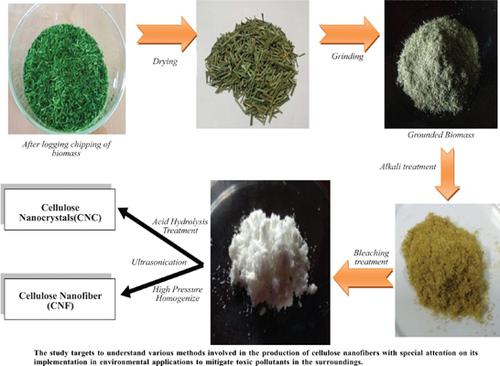Current Analytical Chemistry ( IF 1.7 ) Pub Date : 2021-08-31 , DOI: 10.2174/1573411016666200116094005 Ria Majumdar 1 , Umesh Mishra 1 , Muthusivaramapandian Muthuraj 2 , Biswanath Bhunia 2

|
Background: Plants are considered an important feedstock for cellulose, although algae can be used as a reservoir for the extraction of cellulose in its pure form. Cellulose nanofiber extracted from plant and algae gains more attention among researchers due to their size in the nano range, low cost for preparation, higher surface area available for tuning, outstanding mechanical properties and eco-friendly nature. However, the quality of nanofiber depends on the extraction procedure and feedstock used for their extraction. Furthermore, the extracted nanofiber from lignocellulosic biomass is not compatible with liquid and polymeric matrices due to less amount of functional groups present on their surface. Therefore, it is urged to comprehend the explicit protocol required for the extraction of highly resourceful nanofibers from specific lignocellulosic biomass and surface tuning strategy, which can augment their application in various fields. The present review targets to understand the various polysaccharides, lignin and production of cellulose nanofibers in an economical & efficient way with special attention on its implementation in environmental applications to mitigate the toxic pollutants from our surroundings.
Methods: Research articles related to the cellulose types, feedstocks, physico-chemical features, various extraction and conversion techniques, functionalization methods, and applications on mitigating environmental pollution were collected and reviewed. This review article comprises sections which present various cellulose and nanocellulose types, feedstocks, followed by their extraction, characterization and applications in mitigation of environmental issues such as heavy metal contaminations.
Results: Studies highlighted in the article detailed types of extraction protocols, so far developed and strategies applied to improve the salient properties of nanofibers for specific applications are enlightened.
Conclusion: The functionalized or modified cellulose and nanocellulose have gained significant attention attributed to their unique characteristics, physico-chemical characteristics and efficiency in recovery of environmental pollutants. Thus, further exploitation of such natural resources in mitigation of various environmental issues and other related applications are to be maximized.
中文翻译:

从木质纤维素生物质中回收纤维素纳米纤维:最新趋势和应用
背景:植物被认为是纤维素的重要原料,尽管藻类可用作提取纯形式纤维素的储库。从植物和藻类中提取的纤维素纳米纤维由于其尺寸在纳米范围内、制备成本低、可用于调谐的表面积更大、优异的机械性能和生态友好性而受到研究人员的更多关注。然而,纳米纤维的质量取决于提取程序和用于提取的原料。此外,从木质纤维素生物质中提取的纳米纤维与液体和聚合物基质不相容,因为它们表面上存在的官能团数量较少。所以,敦促理解从特定木质纤维素生物质中提取资源丰富的纳米纤维所需的明确协议和表面调整策略,这可以扩大其在各个领域的应用。本综述旨在以经济有效的方式了解各种多糖、木质素和纤维素纳米纤维的生产,特别关注其在环境应用中的实施,以减轻我们周围环境中的有毒污染物。
方法:收集和审查与纤维素类型、原料、理化特性、各种提取和转化技术、功能化方法以及减轻环境污染的应用相关的研究文章。这篇评论文章包括介绍各种纤维素和纳米纤维素类型、原料的部分,然后是它们的提取、表征和缓解环境问题(如重金属污染)的应用。
结果:文章中强调的研究详细类型的提取协议,迄今为止开发的和用于改善特定应用的纳米纤维显着特性的策略都受到启发。
结论:功能化或改性的纤维素和纳米纤维素因其独特的特性、理化特性和环境污染物回收效率而受到广泛关注。因此,在缓解各种环境问题和其他相关应用中进一步开发此类自然资源将被最大化。











































 京公网安备 11010802027423号
京公网安备 11010802027423号